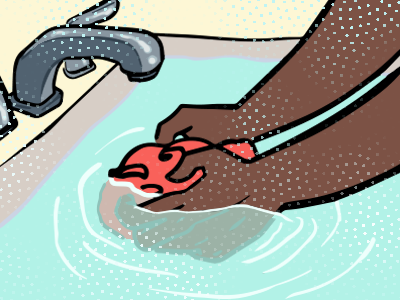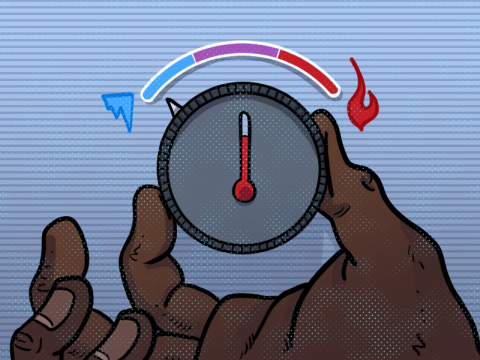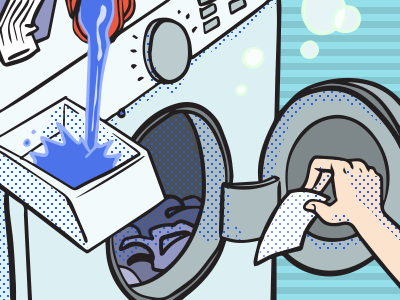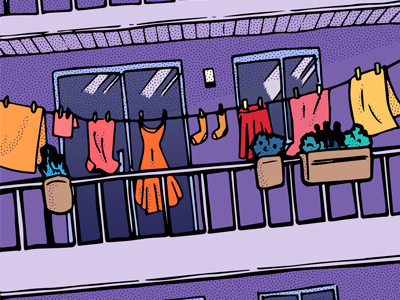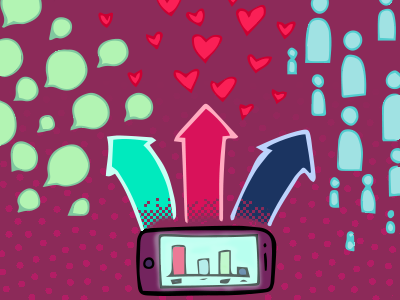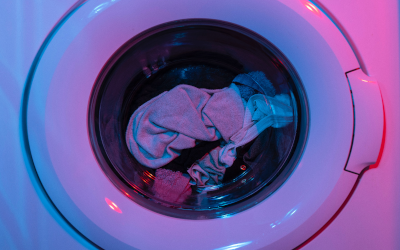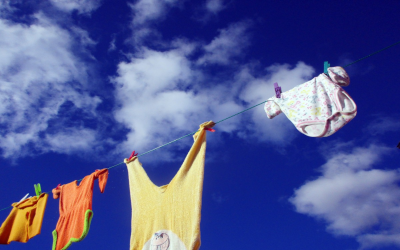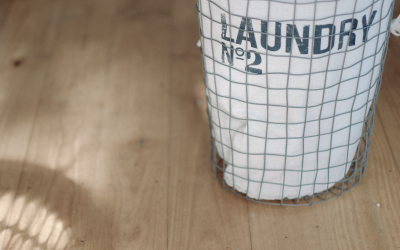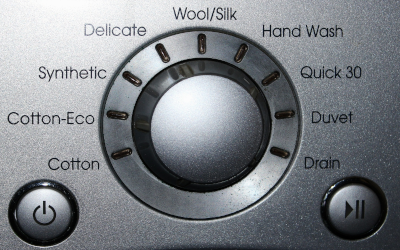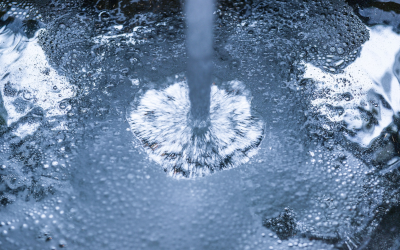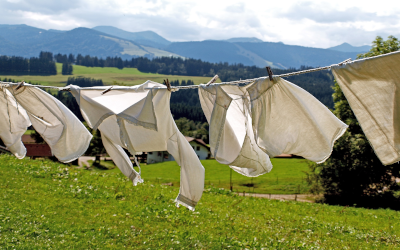
Wash Smarter
How This Helps
Washing smarter protects our water systems by reducing water consumption and pollution.
What You May Need
- A device with internet access
- Somewhere to record your notes (notebook or google doc)
- Optional:
- A washing machine, sink, or wash basin
- Laundry detergent
- A microplastics filter or laundry bag
- Stain removers
- A clothesline or hanger
Things To Think About
Image - Text Version
Shown is a colour, comic book style illustration of a t-shirt over a laundry hamper, surrounded by question marks.
The t-shirt is green, on a bright pink background, with a translucent laundry basket underneath. Four areas on the shirt are magnified in round bubbles and labelled with purple question marks. A yellow area under the right arm, a spot on the left shoulder, dirt or crumbs on the left chest area, and a brown stain in the bottom right corner.
Washing your clothes uses lots of water. It also causes chemical and microfibre pollution. The best way to wash smarter is to wash less! Of course we need to keep our clothes clean. But have you ever really thought about how often you wash your clothing? The next time you throw something in the dirty pile, ask yourself:
- How many times have I worn this?
- Is it stained?
- Does it have an odor?
- Is it dirty?
How often will you wash your clothes?
Image - Text Version
Shown is a colour, comic book style illustration of a t-shirt over a laundry hamper, surrounded by question marks.
The t-shirt is green, on a bright pink background, with a translucent laundry basket underneath. Four areas on the shirt are magnified in round bubbles and labelled with purple question marks. A yellow area under the right arm, a spot on the left shoulder, dirt or crumbs on the left chest area, and a brown stain in the bottom right corner.
Washing your clothes uses lots of water. It also causes chemical and microfibre pollution. The best way to wash smarter is to wash less! Of course we need to keep our clothes clean. But have you ever really thought about how often you wash your clothing? The next time you throw something in the dirty pile, ask yourself:
- How many times have I worn this?
- Is it stained?
- Does it have an odor?
- Is it dirty?
Image - Text Version
Shown is a colour, comic book style illustration of a pair of hands with brown skin, holding red fabric in a sink filled with water.
The arms are shown from the elbow down, coming in from the top left corner of the panel. Both hands grasp a bundle of red fabric and hold it under translucent water. Ripple lines on the surface indicate that the hands are moving. On the top right, silver coloured taps can be seen at the edge of the sink.
How you wash your clothes makes a big difference to the environment. Washing your clothes by hand uses a lot less water than using a machine. The type of washing machine you use also makes a difference.
Consider the following questions:
- Is the washing machine I use top loading, or front loading?
- How old is the washing machine? Is it energy efficient?
- What setting do I choose? How much water does that use?
- Am I able to wash my clothes by hand?
How do you wash your clothes?
Image - Text Version
Shown is a colour, comic book style illustration of a pair of hands with brown skin, holding red fabric in a sink filled with water.
The arms are shown from the elbow down, coming in from the top left corner of the panel. Both hands grasp a bundle of red fabric and hold it under translucent water. Ripple lines on the surface indicate that the hands are moving. On the top right, silver coloured taps can be seen at the edge of the sink.
How you wash your clothes makes a big difference to the environment. Washing your clothes by hand uses a lot less water than using a machine. The type of washing machine you use also makes a difference.
Consider the following questions:
- Is the washing machine I use top loading, or front loading?
- How old is the washing machine? Is it energy efficient?
- What setting do I choose? How much water does that use?
- Am I able to wash my clothes by hand?
Image - Text Version
Shown is a colour, comic book style illustration of two laundry baskets. One has a few clothes in the bottom, the other is almost full.
The baskets are identical, translucent, on a dark green background. They are divided by a pair of wavy, pale green lines. The basket on the left has a few clothes in the bottom. The basket on the right is almost full to the top, with two socks hanging over the rim.
The size of the loads you put in a washing machine has a big impact on your water use over time. Before you hit the start button, consider:
- Is the machine full?
- If not, can I wait until I have enough clothes for a full load?
- Does anyone else in my house have clothes I can add to this load?
How many clothes are you washing?
Image - Text Version
Shown is a colour, comic book style illustration of two laundry baskets. One has a few clothes in the bottom, the other is almost full.
The baskets are identical, translucent, on a dark green background. They are divided by a pair of wavy, pale green lines. The basket on the left has a few clothes in the bottom. The basket on the right is almost full to the top, with two socks hanging over the rim.
The size of the loads you put in a washing machine has a big impact on your water use over time. Before you hit the start button, consider:
- Is the machine full?
- If not, can I wait until I have enough clothes for a full load?
- Does anyone else in my house have clothes I can add to this load?
Image - Text Version
Shown is a colour, comic book style illustration of a hand with dark brown skin turning a dial from hot to cold.
The grey dial has a red thermometer symbol in the centre. It is set on a blueish grey background. Above it, a scale goes from blue on the left to red on the right. There is an ice symbol on the left end of the scale, and a flame symbol on the right. A hand is reaching up from the bottom edge of the frame to turn the dial.
Once you have a full load of dirty laundry, it is important to think about the temperature of your water. Washing your clothes in cold water reduces microplastic pollution, dye pollution, and it is more gentle on your clothing.
Do some research on the temperature settings of your washing machine. Do you know the difference between “cold” and “tap cold”? Is it ever necessary to wash anything on “hot”?
Make sure to also look at the labels on your clothing for washing instructions.
What temperature is your wash water?
Image - Text Version
Shown is a colour, comic book style illustration of a hand with dark brown skin turning a dial from hot to cold.
The grey dial has a red thermometer symbol in the centre. It is set on a blueish grey background. Above it, a scale goes from blue on the left to red on the right. There is an ice symbol on the left end of the scale, and a flame symbol on the right. A hand is reaching up from the bottom edge of the frame to turn the dial.
Once you have a full load of dirty laundry, it is important to think about the temperature of your water. Washing your clothes in cold water reduces microplastic pollution, dye pollution, and it is more gentle on your clothing.
Do some research on the temperature settings of your washing machine. Do you know the difference between “cold” and “tap cold”? Is it ever necessary to wash anything on “hot”?
Make sure to also look at the labels on your clothing for washing instructions.
Image - Text Version
Shown is a colour, comic book style illustration of a hand with pale skin putting a white rectangle into a washing machine, and purple liquid pouring into the detergent compartment from above.
The washing machine is front loading and the door is open. A hand with pale skin is reaching to put a thin white rectangle inside. The detergent compartment of the machine is open, and purple liquid is pouring into it from an orange bottle above, outside the frame. A few bubbles float in the air around the machine.
Many detergents and stain removers contain phosphorus, nitrogen and other harsh chemicals. These contribute to water pollution.
Do some research to decide which detergents are less dangerous for the environment. You can also try the compare detergents action to see how you can make good choices about your detergent.
What detergents and chemicals are you using?
Image - Text Version
Shown is a colour, comic book style illustration of a hand with pale skin putting a white rectangle into a washing machine, and purple liquid pouring into the detergent compartment from above.
The washing machine is front loading and the door is open. A hand with pale skin is reaching to put a thin white rectangle inside. The detergent compartment of the machine is open, and purple liquid is pouring into it from an orange bottle above, outside the frame. A few bubbles float in the air around the machine.
Many detergents and stain removers contain phosphorus, nitrogen and other harsh chemicals. These contribute to water pollution.
Do some research to decide which detergents are less dangerous for the environment. You can also try the compare detergents action to see how you can make good choices about your detergent.
Image - Text Version
Shown is a colour, comic book style illustration of three different microplastic filters, in front of an open washing machine.
The background is the open, glass door of a front loading washing machine. A pair of light brown hands reach up from the bottom edge, holding a translucent drawstring bag filled with pink fabric. On the top right, a blue ball with a loopy texture floats in the foreground. Below floats a rectangular white bag with a zipper closure.
Microplastics are tiny pieces of plastic that fall off synthetic clothing in the wash. This plastic ends up in our waterways, all over the world. Microplastics are very harmful to ecosystems.
Think about how you can reduce microplastic pollution when you wash your clothes.There are many different filters available, like the Coraball, the Filtrol or the GuppyFriend.
Research the options to see which one would work best for you. You can also check out this action to make your own filter.
How will you prevent microplastic pollution?
Image - Text Version
Shown is a colour, comic book style illustration of three different microplastic filters, in front of an open washing machine.
The background is the open, glass door of a front loading washing machine. A pair of light brown hands reach up from the bottom edge, holding a translucent drawstring bag filled with pink fabric. On the top right, a blue ball with a loopy texture floats in the foreground. Below floats a rectangular white bag with a zipper closure.
Microplastics are tiny pieces of plastic that fall off synthetic clothing in the wash. This plastic ends up in our waterways, all over the world. Microplastics are very harmful to ecosystems.
Think about how you can reduce microplastic pollution when you wash your clothes.There are many different filters available, like the Coraball, the Filtrol or the GuppyFriend.
Research the options to see which one would work best for you. You can also check out this action to make your own filter.
Image - Text Version
Shown is a colour, comic book style illustration of a full clothesline strung across a balcony.
The clothesline arcs across the illustration. Yellow, orange, pink and red garments are pinned along it. In the background is a purple apartment with a window and a sliding door facing the balcony. In the foreground is a pale purple railing. The floor of another balcony can be seen above.
How you dry your clothes also has an impact on the environment. Putting your clothes in a dryer releases microfibres. It also makes your clothes wear out faster. This means more clothes go into landfills. Landfills leach harmful chemicals into groundwater.
Think about creative ways you can air dry your clothes to reduce pollution and keep your clothes looking new!
How will you dry your clothes?
Image - Text Version
Shown is a colour, comic book style illustration of a full clothesline strung across a balcony.
The clothesline arcs across the illustration. Yellow, orange, pink and red garments are pinned along it. In the background is a purple apartment with a window and a sliding door facing the balcony. In the foreground is a pale purple railing. The floor of another balcony can be seen above.
How you dry your clothes also has an impact on the environment. Putting your clothes in a dryer releases microfibres. It also makes your clothes wear out faster. This means more clothes go into landfills. Landfills leach harmful chemicals into groundwater.
Think about creative ways you can air dry your clothes to reduce pollution and keep your clothes looking new!
Image - Text Version
Shown is a colour, comic book style illustration of a smartphone with three arrows emerging from it, surrounded by speech bubbles, red hearts, and symbols for individual people.
The phone is horizontal at the bottom of the panel, with a bar graph on the screen. A green arrow, a red arrow, and a blue arrow point up and out from the phone. The green arrow points to a cloud of green speech bubbles. The red arrow points to red hearts. The blue arrow points to simplified human figure symbols blue torsos and round heads. All these symbols float above the phone on a purple background.
Now that you know how to make smart choices about washing your clothes, how will you share your tips with others? How will you make this information interesting and easy to understand?
You could:
- Make an infographic
- Create a social media campaign
- Make a video
How will you encourage others to wash smarter?
Image - Text Version
Shown is a colour, comic book style illustration of a smartphone with three arrows emerging from it, surrounded by speech bubbles, red hearts, and symbols for individual people.
The phone is horizontal at the bottom of the panel, with a bar graph on the screen. A green arrow, a red arrow, and a blue arrow point up and out from the phone. The green arrow points to a cloud of green speech bubbles. The red arrow points to red hearts. The blue arrow points to simplified human figure symbols blue torsos and round heads. All these symbols float above the phone on a purple background.
Now that you know how to make smart choices about washing your clothes, how will you share your tips with others? How will you make this information interesting and easy to understand?
You could:
- Make an infographic
- Create a social media campaign
- Make a video
Share your guide!
We would love to see how you decided to wash smarter!
Get Inspired
Go Further
- Now that you know how to wash smarter, you could try removing a stain or testing some different detergents!
- Compare your wash smarter guide with other students in your class or school and see how they chose to wash smarter!
- Investigate how you could use a microplastics filter to prevent microplastic pollution. Find a community group giving away free filters or design your own!

